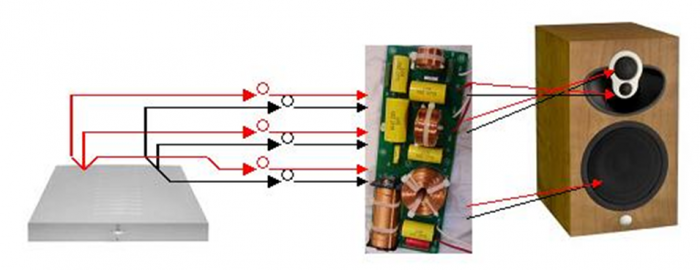Tri-Wire
This is using the same Power Amplifier but using individual speakers cables to the loudspeaker Passive crossover. The bridging links at the rear of of the speaker are removed.
- What is the benefits of this?
- All conventional loudspeaker drive units are reciprocal transducers – they work as microphones too. When a drive unit diaphragm is caused to move, by application of current or by external force, it generates a small voltage in the motor of the driver which is ‘returned’ to the electrical input. This returned signal is the back e.m.f.
- The back e.m.f. can only be removed if it sees a short (zero ohms) back to an amplifier with a (near) zero ohm output impedance. With a crossover and cable between the drive units and the amplifier back e.m.f. will always be a problem.
- The most common approach to reducing the impact of back e.m.f on the playback system is by multi-wiring, Bi-Wire, Tri-wire, Quad-wire...
- Removing the link plate from the crossover and running multiple cables to a single amplifier keeps the back e.m.f. of each driver separate until they reach the amplifier terminals.
- This allows the amplifier to better damp the back e.m.f. of each drive unit without polluting the signal seen by the other drivers in the system.
- Multi wiring by no means eliminates the deleterious effects of back e.m.f. but it does reduce them.
- Tri-wire Example
